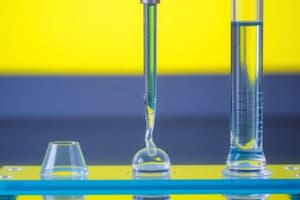Podcast
Questions and Answers
What primary factor affects the viscosity of a liquid at different temperatures?
What primary factor affects the viscosity of a liquid at different temperatures?
- Molecular Weight
- Density
- Chemical Reactivity
- Molecular Structure (correct)
Which intermolecular force primarily influences the viscosity of a liquid?
Which intermolecular force primarily influences the viscosity of a liquid?
- Van der Waals Forces (correct)
- Nuclear Force
- Gravitational Force
- Electromagnetic Force
How do impurities in a liquid generally affect its viscosity?
How do impurities in a liquid generally affect its viscosity?
- Lower the density
- Have no effect on viscosity
- Increase the boiling point
- Alter the intermolecular forces (correct)
Which of the following factors has the least impact on the viscosity of a liquid?
Which of the following factors has the least impact on the viscosity of a liquid?
What is the effect of increasing pressure on the viscosity of a liquid?
What is the effect of increasing pressure on the viscosity of a liquid?
Which tool is used in the experience to examine samples under magnification?
Which tool is used in the experience to examine samples under magnification?
What is surface tension best described as?
What is surface tension best described as?
Which of the following materials was mentioned as part of the experience tools?
Which of the following materials was mentioned as part of the experience tools?
Which characteristic of liquids is demonstrated by surface tension?
Which characteristic of liquids is demonstrated by surface tension?
In the context of the experience, what could the different colors of paraffin represent?
In the context of the experience, what could the different colors of paraffin represent?
What is the calculated slope from the given data?
What is the calculated slope from the given data?
What is the value of 'g' calculated from the slope?
What is the value of 'g' calculated from the slope?
Which value corresponds to the time (t) when the distance is 80 cm?
Which value corresponds to the time (t) when the distance is 80 cm?
What is the change in time (∆t) between the distances of 90 cm and 80 cm?
What is the change in time (∆t) between the distances of 90 cm and 80 cm?
How does the acceleration due to gravity (g) relate to the slope value?
How does the acceleration due to gravity (g) relate to the slope value?
What is the calculated value of $X$ in the angle of contact calculation?
What is the calculated value of $X$ in the angle of contact calculation?
What is the value of $Y$ in the angle of contact calculation?
What is the value of $Y$ in the angle of contact calculation?
What is the final calculated angle $ heta$ in the angle of contact calculation?
What is the final calculated angle $ heta$ in the angle of contact calculation?
In the context of free fall, what is the primary aim of the experiment mentioned?
In the context of free fall, what is the primary aim of the experiment mentioned?
Which of the following equations is used to find $tan \theta$ in the calculation?
Which of the following equations is used to find $tan \theta$ in the calculation?
What happens to the surface tension coefficient of a liquid when its temperature is raised?
What happens to the surface tension coefficient of a liquid when its temperature is raised?
Which of the following factors does not affect the surface tension coefficient of a liquid?
Which of the following factors does not affect the surface tension coefficient of a liquid?
Which of these is NOT a factor that affects surface tension of a liquid?
Which of these is NOT a factor that affects surface tension of a liquid?
How do surfactants, such as soap, generally affect the surface tension of a liquid?
How do surfactants, such as soap, generally affect the surface tension of a liquid?
If a liquid has impurities, how does it generally affect the surface tension coefficient?
If a liquid has impurities, how does it generally affect the surface tension coefficient?
What is the formula used to calculate Young's modulus from the slope?
What is the formula used to calculate Young's modulus from the slope?
Which factors do NOT affect Young's modulus?
Which factors do NOT affect Young's modulus?
What will be the slope calculation using the given values for mass 50 gm and mass 40 gm?
What will be the slope calculation using the given values for mass 50 gm and mass 40 gm?
What does Young's modulus depend on?
What does Young's modulus depend on?
What is the value of Young's modulus for the material given that the slope calculation resulted in 0.005 and assuming W is 980 g?
What is the value of Young's modulus for the material given that the slope calculation resulted in 0.005 and assuming W is 980 g?
Flashcards
Young's Modulus
Young's Modulus
A measure of a material's stiffness or resistance to deformation under tensile stress.
Factors affecting Young's Modulus
Factors affecting Young's Modulus
The factors that influence Young's Modulus include: the material's composition, the temperature, the microstructure, and the presence of impurities or defects.
Strain (∆L/L)
Strain (∆L/L)
The change in length of a material divided by the original length. It is a measure of the material's strain.
Slope (∆M/∆L)
Slope (∆M/∆L)
Signup and view all the flashcards
Young's Modulus Calculation
Young's Modulus Calculation
Signup and view all the flashcards
Viscosity
Viscosity
Signup and view all the flashcards
Temperature's effect on viscosity
Temperature's effect on viscosity
Signup and view all the flashcards
Molecular Structure and Viscosity
Molecular Structure and Viscosity
Signup and view all the flashcards
Intermolecular Forces and Viscosity
Intermolecular Forces and Viscosity
Signup and view all the flashcards
Pressure's effect on viscosity
Pressure's effect on viscosity
Signup and view all the flashcards
Paraffin (wax)
Paraffin (wax)
Signup and view all the flashcards
Glass Slide
Glass Slide
Signup and view all the flashcards
Microscope
Microscope
Signup and view all the flashcards
Surface tension
Surface tension
Signup and view all the flashcards
Surface tension
Surface tension
Signup and view all the flashcards
Temperature and Surface Tension
Temperature and Surface Tension
Signup and view all the flashcards
Nature of Liquid and Surface Tension
Nature of Liquid and Surface Tension
Signup and view all the flashcards
Impurities and Surface Tension
Impurities and Surface Tension
Signup and view all the flashcards
Angle of Contact
Angle of Contact
Signup and view all the flashcards
Ground Acceleration (g)
Ground Acceleration (g)
Signup and view all the flashcards
Velocity in Free Fall
Velocity in Free Fall
Signup and view all the flashcards
Free Fall
Free Fall
Signup and view all the flashcards
Tangent Function (tan)
Tangent Function (tan)
Signup and view all the flashcards
Velocity
Velocity
Signup and view all the flashcards
Acceleration
Acceleration
Signup and view all the flashcards
Slope of a displacement-time squared graph
Slope of a displacement-time squared graph
Signup and view all the flashcards
g (Acceleration due to gravity)
g (Acceleration due to gravity)
Signup and view all the flashcards
Meter per second squared (m/s²)
Meter per second squared (m/s²)
Signup and view all the flashcards
Study Notes
Viscosity of a Liquid (Stock's Method)
- Aim: To determine the viscosity of a liquid (glycerin) using Stoke's Law.
- Tools:
- One-ended closed glass tube filled with glycerin
- Metal balls of various sizes
- Metric ruler
- Stopwatch
- Micrometer/ruler
- Purpose of dropping balls from one position: To reduce experimental errors and ensure consistent results.
- Factors affecting viscosity: Temperature, molecular structure, intermolecular forces, pressure, impurities.
- Calculation of viscosity:
- Data collected includes: ball diameter (D), radius (r), radius squared (r²), time taken for fall (t), velocity (v).
- Formula used in calculation: n = 5 * g * (ps - pl) * slope (where 'n' is viscosity; g = gravity, ps=density of sphere, pl = density of liquid, and the slope is derived from a graph of velocity vs radius squared).
Boyle's Law
- Aim: To determine atmospheric pressure using Boyle's Law.
- Tools:
- Boyle's device (a U-shaped glass tube with one end closed)
- Mercury
- Thermometer
- Why mercury: Mercury's high density, non-compressibility, and stability make it suitable for precise measurements.
- Relationship between pressure and volume: Inversely proportional (P1V1 = P2V2)
- Convex surface of mercury in tube: Cohesive forces between mercury molecules are stronger than adhesive forces between mercury and glass.
- Calculation of atmospheric pressure: Data collected includes: initial volume, final volume, and corresponding pressure readings. The formula used for calculating atmospheric pressure is Pο= |-76|.
Young's Modulus of Elasticity
-
Aim: To determine the Young's modulus of a material.
-
Tools:
- Horizontal ruler
- Holder
- Weights
- Micrometer
-
Factors affecting Young's modulus: Material composition, temperature, microstructure, impurities, defects.
-
Stress: Force acting on a unit area.
-
Compliance: The ability of a material to deform or respond to an applied stress.
-
Calculation of Young's Coefficient: Data collected includes: mass (M) and change in length (AL). Formula is Y = slope × W * 980, where slope is calculated by dividing change in AL (in cm) by mass change (in gm) and W is the width used.
Surface Tension
- Aim: To study surface tension and its relation to wax color.
- Tools:
- Paraffin wax in different colors
- Glass slide
- Microscope
- Surface tension: The phenomenon where the surface layer of a liquid acts like an elastic sheet, enabling certain objects to float.
- Factors affecting surface tension: Temperature, nature of the liquid, impurities, surfactants.
- Cohesive forces: Attractive forces between molecules within a substance.
- Adhesive forces: Attractive forces between molecules of different substances, as seen when a liquid affects a material.
- What happens to surface tension at boiling point: Becomes zero.
- What happens to the coefficient of surface tension when heated: Decreases.
Free Fall
- Aim: To determine the acceleration due to gravity (g).
- Tools:
- Metal ball attached to a magnetic device
- Mechanical shock sensitive switch
- Electronic watch
- Metric ruler
- Method: Dropping the metal ball and timing its fall from varying points.
- Calculation of acceleration: Data collected includes distance (S), time (t), squared time (t²), and the slope which is calculated from graph of S against t². Formula is g = 2 × slope.
Studying That Suits You
Use AI to generate personalized quizzes and flashcards to suit your learning preferences.




